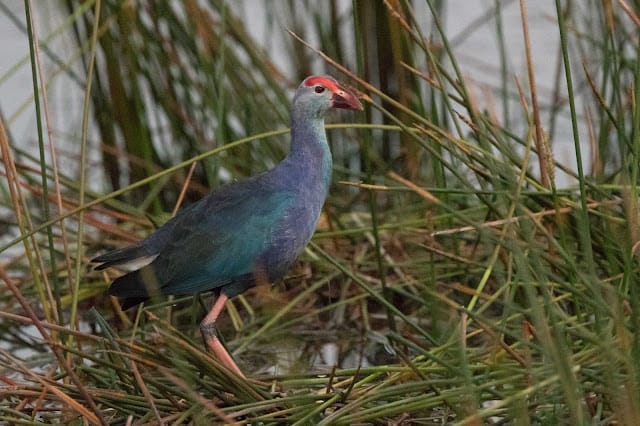Today we were up at 03:45 for a 04:15 departure from our hotel in Port Blair with a limited number of endemic birds to see. We headed back to the Government Secondary School in Port Blair to try for Barn Owl of the endemic subspecies deroepstorffi. Arriving just as the sun was rising we waited for 30 minutes and once again despite hearing the bird there was no sight of it.
We then headed around Flat Bay stopping at various wetlands looking for Andaman Teal. The water bodies held good numbers of birds with Purple Gallinule, Yellow Bittern, Cinnamon Bittern, Cotton Pygmy-goose, Lesser Whistling Duck, Intermediate Egret, Striated Heron, Pacific Golden-plover, Red-throated Pipit and Eastern Yellow Wagtail, but we had no luck with the Teal.
We reached the main pool for the Andaman Teal located approximately 1.5km south-east of Tusnabad, this was a very large lake surrounded by rushes, sedges, reed and papyrus with extensive areas of open mud. There were many waders with the highlights being Long-toed Stint (55), Red-necked Stint , Oriental Pratincole , Wood Sandpiper (c.75), Whimbrel, Pacific Golden-plover, a winter plumage Broad-billed Sandpiper and Curlew Sandpiper . In the surrounding scrub we recorded Oriental Reed-warbler and Dusky Warbler but again there was no sign of the Teal.
We then headed over the island to Chidiatapu Biological Park. It was fairly slow going but we had only two main targets. Walking past the pens containing various deer we recorded Grey-capped Emerald Dove, Green Imperial-pigeon and Changeable Hawk-eagle. There was a shout and a quick sprint and Jejo had found our first target, an Andaman Serpent-eagle soaring over the canopy. Wandering on we recorded Greenish Warbler, Yellow-browed Warbler and then Barry found our last target, three Andaman Wood-pigeon perched quietly within the under scrub and lower canopy.
Purple Gallinule – Near to Chouldari, Andaman Islands
Pacific Golden-plover – Near to Chouldari, Andaman Islands
Whimbrel of subspecies variegatus- Near to Chouldari, Andaman Islands
White-breasted Kingfisher – Near to Chouldari, Andaman Islands
Great Egret – Near to Chouldari, Andaman Islands
Yellow Bittern – Near to Chouldari, Andaman Islands
Redshank of subspecies eurina – Near to Chouldari, Andaman Islands
Wood Sandpiper – Near to Chouldari, Andaman Islands
Eastern Yellow Wagtail – Near to Chouldari, Andaman Islands
Lesser Whistling-duck – Near to Chouldari, Andaman Islands
Andaman Green Bronzeback -Chidiatapu Biological Park, Andaman Islands
Grey-capped Emerald Dove -Chidiatapu Biological Park, Andaman Islands
Andaman Serpent-eagle -Chidiatapu Biological Park, Andaman Islands
Andaman Woodpigeon -Chidiatapu Biological Park, Andaman Islands
Dragonfly species -Chidiatapu Biological Park, Andaman Islands
Changeable Hawk-eagle -Chidiatapu Biological Park, Andaman Islands
We headed back to the hotel for lunch and a siesta in the heat of the day before heading back out at 2:45 for another try for the Andaman Teal south-east of Tusnabad. We briefly scanned the first ponds making our way for the main pond.
There were far more waders this afternoon with perhaps 175 Long-toed Stint and 25 Red-necked Stint with larger numbers of most of the other species we had previously recorded. Barry then located four Andaman Teal and we enjoyed rather distant views of this rare species as they preened on the edge of the pond. This was the last endemic species we needed.
Come 16:30 we needed to head for the bus to get back to the Barn Owl site before dusk. Once again we were unsuccessful with this subspecies and all that we succeeded in was being eaten alive by mosquito. We headed back to the hotel to pack for tomorrows flight to Chenai and enjoyed our final Indian buffet and Kingfisher beers.
Distant shot of our last endemic, Andaman Teal – Near to Tusnabad, Andaman Islands
List of Birds Recorded in the Andaman Islands. We recorded 114 species, 22 of which were ticks for me (shown in bold). All ticks were Andaman endemics with the exception of Lesser Cuckoo and Indian Cuckoo. We saw all of the endemic species of the Andaman Islands.
Simon Colenutt
I began birdwatching at the age of nine when living on the Isle of Wight. After obtaining a copy of the Isle of Wight Bird Report from 1976 I realised that Manx Shearwater, Arctic Skua, Pomarine Skua and Black Tern were regularly seen at St.Catherine's Point, only five miles from my home village of Chale Green. To a nine year old these birds were near mythical and so I just had to go and try to see them. Little did I know that these birds were seasonal and after a long winter of seeing nothing I eventually started to bump into other birdwatchers as March drew to a close. It was then that Dave Hunnybun, Dave Wooldridge, Paul Castle, Peter Gandy and Audrey Wilkinson introduced me to the art of seawatching and the joys of bird migration, I have not looked back since.



















Leave a Reply